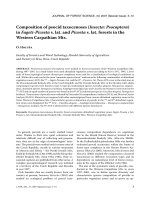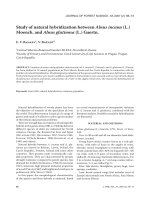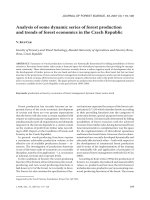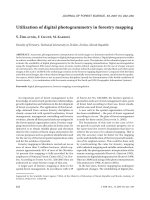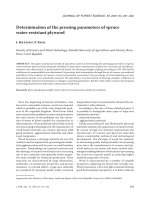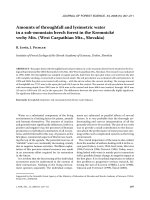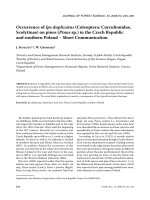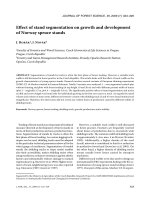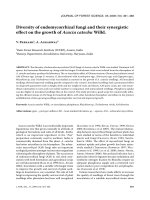Báo cáo lâm nghiệp: "Effect of defoliation by Thaumetopoea pityocampa (Den. & Schiff.) (Lepidoptera: Thaumetopoeidae) on annual diameter increment of Pinus brutia Ten. in Turkey" ppt
Bạn đang xem bản rút gọn của tài liệu. Xem và tải ngay bản đầy đủ của tài liệu tại đây (113.1 KB, 4 trang )
91
Ann. For. Sci. 62 (2005) 91–94
© INRA, EDP Sciences, 2005
DOI: 10.1051/forest:2004095
Original article
Effect of defoliation by Thaumetopoea pityocampa (Den. & Schiff.)
(Lepidoptera: Thaumetopoeidae) on annual diameter increment
of Pinus brutia Ten. in Turkey
Mehmet KANAT
a
*, M. Hakki ALMA
b
*, Fatih SIVRIKAYA
a
a
Department of Forest Engineering, Faculty of Forestry, Kahramanmaras Sutcu Imam University, 46060 Kahramanmaras, Turkey
b
Department of Industrial Engineering of Forestry, Faculty of Forestry, Kahramanmaras Sutcu Imam University, 46060 Kahramanmaras, Turkey
(Received 13 October 2003; accepted 24 May 2004)
Abstract – In this study, the influence of defoliation by pine processionary moth, Thaumetopoea pityocampa (Den. & Schiff.) (Lepidoptera:
Thaumetopoeidae) on the annual diameter increment of Turkish Calabrian pine, Pinus brutia Ten. in Kahramanmaras province, Turkey, was
investigated. The study was carried out between 1995 and 1998. During the four years, the defoliation of pine processionary moth caused a
significant decrease (average 21% for four years, P < 0.05) in the annual diameter increment with respect to control, undefoliated trees.
Thaumetopoea pityocampa / diameter increment / Kahramanmaras / Turkey / Pinus brutia
Résumé – Effet des défeuillaisons par Thaumetopoea pityocampa (Den. & Schiff.) sur l’accroissement annuel de Pinus brutia Ten. en
Turquie. L’influence de défeuillaisons par la processionnaire du Pin Thaumetopoea pityocampa, sur l’accroissement annuel en diamètre de
Pinus brutia, a été testée dans la province de Kahramanmaras, en Turquie. L’étude fut conduite de 1995 à 1998. Durant ces 4 années, les
défeuillaisons ont causé une diminution significative (en moyenne 21 % pour les 4 ans, P < 0,05) de l’accroissement annuel en diamètre, en
comparaison avec des témoins non défeuillés.
Thaumetopoea pityocampa / accroissement en diamètre / Kahramanmaras / Turquie / Pinus brutia
1. INTRODUCTION
The pine processionary moth (PPM) live on the genera Pinus
and Cedrus grown in Cyprus, Turkey and Middle East and has
been known as Thaumetopoea pityocampa (Den. & Schiff.)
until now, except for the population found in the province of
Aydn, Aegean region of Turkey [27]. However, there is the
possibility that the species studied in this paper may refer to
Th. wilkinsoni Tams known from Cyprus, Eastern Turkey, and
Israel [27]. Further studies are needed to clarify the taxonomic
position of the studied populations.
Th. pityocampa Schiff is known to feed on leaves and build
large silk nests on the top of the trees. In addition, PPM has
urticating hairs, which cause allergies resulting in conjunctivitis,
respiratory congestions and asthma [29]. The PPM is one of the
most harmful insect that defoliates Pinus and Cedrus and has
serious economic importance [2, 4, 5, 8, 16, 20–24, 26, 28]. In
mature forests, trees are barely killed, but significant losses
bring about in volume and radial growths [18].
It is well known that defoliation may increase tree stress and
their susceptibility to secondary pests such as bark beetles and
pine weevils, particularly in young trees [11, 15, 16]. Outbreaks
of PPM are quite periodic, occurring every 5–7 years. It was
also reported that losses in total shoots of P. pinaster were
between 41–50% in moderately defoliated trees and between
54–64% in completely defoliated trees [25]. Due to PPM attack
on Pinus brutia (with 1–4 m height) in Turkey, a great loss of
68% was determined by Babur [5].
PPM has been damaging pine species (i.e., Pinus brutia,
P. nigra, P. sylvestris, P. pinea, and P. halepensis) as well as
species Cedrus libani growing in Turkey. The PPM occurs at
the regions from sea level to an altitude of 1 800 meters [3, 12]
at different levels of intensity. In Turkey, the PPM is available
in a forest area of 1 500 000 hectares [1].
The damage of PPM has been mostly observed on P. brutia
in Turkey, which consists of the majority of forests (with more
than 3 million hectares) and are distributed particularly in the
coastal regions of Turkey, namely, the Mediterranean (47%),
* Corresponding authors: ,
92 M. Kanat et al.
Marmara regions (40%) and Aegean (10%) [1, 12]. It has a vol-
ume of more than 161 million m
3
and an annual volume incre-
ment of more than 5 million m
3
, 4 million m
3
of which is
allowed to be cut [6]. The PPM created severe damage in an
area of about 1.5 million hectares in Turkey [1]. It was reported
that the damage resulted from larvae being nourished with the
needles of P. brutia and P. nigra continued for about 7 or
8 months to a great extent. Especially, the larvae at the 4th and
5th instars consume all the leaves of the Calabrian pine trees
remarkably. Thereby, the damaged trees look like as if they
were burned [17].
There are several studies on the effects of the attacks of Th.
pityocampa (Den. & Schiff.) on the radial [5, 18, 19], volume
[7, 9] and the height growths [10] of various pine species. To
our knowledge, little information [5, 16] on the effects of the
PPM attack on annual diameter increment of P. brutia has been
known in the literature so far.
Therefore, the aim of this study was to investigate the influ-
ence of damage by the PPM on annual diameter increment of
P. brutia growing in Kahramanmaras, the Eastern Mediterra-
nean region of Turkey.
2. MATERIALS AND METHODS
2.1. Selection of material and study area
The study area of both control and defoliated trees was around Ferhus
village (with plantation forest), within the boundaries of the Directorate
of Kahramanmaras Forest District, Turkey (322 500 E; 41 55 000 N
(UTM grit zone 37 S); altitude 560 m).
Specifically, P. brutia forests in the region of Kahramanmaras
cover an area of 192 521 hectares, which corresponds to 6% of the total
area of P. brutia forests in Turkey. About 87 600 hectares (45%) of
the total area of P. brutia in Kahramanmaras region are unproductive
while the remaining 104 926 hectares (55%) is productive [6, 14].
The diameter at the breast height of both control and defoliated pine
trees (25–35 years old) studied herein varied between 13 and 19 cm.
Undefoliated trees and trees whose about two-thirds of needles of
P. brutia (i.e., especially from the top to middle of tree) were estimated
to have been defoliated by PPM were selected for control and defoli-
ated trees, respectively. The control trees were managed to keep free
of attack throughout by removing the egg batches on trees in Septem-
ber and October. Furthermore, the average height of both control and
defoliated trees in this study ranged between 11–12 m. The exposure
of the study area for both control and defoliated trees were north-east.
2.2. Observation on the PPM defoliation
The feeding of larvae was found to take place much more in April
and May rather than other months in the study area. And then, trees
foliated themselves, starting from May to July. In the study area, the
first natural outbreak was observed in 1994, followed by 1995 (7–
8 nests on each defoliated tree), 1996 (5–6 nests), 1997 (6–7 nests) and
1998 (3–4 nests). It was also observed that PPM laid about 273 eggs
in one egg batch on the needles of P. brutia trees in September, 1995.
Generally speaking, two-thirds of needles of P. brutia (i.e., especially
from the top to middle of tree) were estimated to have been defoliated
by the larvae in these infestation years. About 24% of these eggs were
destroyed due to pressure of some parasitoids and environmental fac-
tors. And then, the number of larvae hatched in September–October
is 208 in each egg batch.
In the study area, the larvae generally entered the soil for pupae in
May, and pupae could live for 4 years in the soil. Between the years
1995 and 1998, the population of PPM remained at a certain level. In
addition, it was observed that in the years at which infestation
decreased, the population of Calosoma sycophanta and Phryxe cau-
data considerably increased.
2.3. Determination of annual diameter increment
The measurements of the diameter at the breast height of P. brutia
trees were obtained using a Pressler increment bore (Djos 400, diameter:
6 mm, height: 33 cm, made in Sweden) and a Zeiss Winkel apparatus
(Dendromotor 2000, made in Finland). Annual diameter increment
(ADI) and percent decrease in annual diameter increment (PDADI)
were determined as follows:
ADI = (D
2
–D
1
) (mm) (1)
where, D
2
is the diameter of the pine tree measured at the end of the
vegetation period of each year and D
1
is the diameter of the tree meas-
ured at the beginning of vegetation period of each year.
PDADI = (ADI
c
–ADI
i
)/ADI
c
× 100 (%) (2)
where, ADI
i
is annual diameter increment for the pine trees defoliated
by PPM and ADI
c
is annual diameter increment for the control pine
trees.
Annual diameter (at the breast height) increments of the pine trees
were measured for four different growing years, namely, 1995, 1996,
1997 and 1998. This study was conducted on the same trees throughout
the studied years. For both the control and defoliated trees, the average
of 30 measurements was reported.
The repeated measurement analysis of variance (rmANOVA) and
Tukey’s mean separation test were applied to determine whether or
not there were significant differences in annual diameter increment of
defoliated and control trees [13].
3. RESULTS AND DISCUSSION
The results of rmANOVA test for the annual diameter incre-
ment of both control and defoliated pine trees are presented in
Table I. As shown in this table, the interaction of defoliation
and growing years studied and year itself are not statistically
significant. However, a strong significant difference is deter-
mined for defoliation, thus revealing that annual diameter
increments in the pine trees are considerably affected by the
defoliation of the larvae, P < 0.05.
The results of Tukey’s mean separation test for the diameter
increment of the both control and defoliated trees as well as per-
cent decrease in annual diameter increment are given in
Table II. As indicated in this table, the annual diameter incre-
ments of the defoliated trees significantly differ from those of
control trees for all the growing years at a significant level of
5%. As one can see from the same table, there are no significant
differences in the annual diameter increments of the defoliated
trees between 1995 and 1998. However, the annual diameter
increments determined in 1996 and 1997 are found to signifi-
cantly differ from those in the other two years, 1995 and 1998,
P < 0.05.
Average decrease in annual diameter increment for four
growing years is about 21%. The greatest percent decrease
(about 30%) in the annual diameter increment of the pine trees
Effect of defoliation by Thaumetopoea pityocampa 93
defoliated by the larvae is for the year of 1995, followed by 20%
in 1997, 18% in 1996 and 14% in 1998, respectively (Tab. II).
This fact can be attributed to the number of nests on defoli-
ated trees in relevant year based upon our observation described
in material and method section. That is to say, the percent
decrease in the annual diameter increment is found to be
directly proportional to the nest number.
It was also reported that due to damage of PPM, an about
23%-loss in annual diameter increment was measured in the
tending felling area of P. brutia in Kapicam village, Kahraman-
maras-Turkey, which is closed to the present study region [16].
Moreover, Laurent-Hervouet [18] found that the PPM
caused a 35%-loss in the diameter increment (radial growth) of
P. nigra subsp. nigricans growing on Mont Ventoux after a
severe attack of Th. pityocampa, which is slightly higher than
the maximum loss (30%) determined in this study. This may
be attributed to both pine species and population of the PPM
depending upon regions [1].
Cadahja and Insua [9] found out the losses in wood volume
increment between 14 and 33% in young reforested area of
P. radiata because of Th. pityocampa. Also, Bouchon and Toth
[7] reported that forests of P. nigra periodically subjected to
heavy attacks of Th. pityocampa showed an about 45%-volume
decrease within 50 years. This difference is due, most probably,
to the age of tree and species [10, 16].
Lemoine [19] also determined a reduction of 30% in radial
growth of P. pinaster in Les Landes (France) after an attack of
Th. pityocampa and 20% loss in radial growth of P. nigra
subsp. laricis in Corsica for the 28 years after the attack of the
same moth. Decrease in the radial growth (about 21%) deter-
mined for P. brutia, studied herein, attacked by the PPM was
evidently smaller than that found for P. pinaster just mentioned
above, and almost the same as that for P. nigra subsp. laricis
grown in Corcica.
Furthermore, Calas [10] found a 60%-reduction in height
growth of P. nigra trees due to Th. pityocampa.
REFERENCES
[1] Anonymous, Harmful insects of forests, The Reports of the 5th
Annual Development Plan, Turkey, 1995.
[2] Austra O., Orlund A.S., Weidahl A., Growth loss and economic
consequences following two years of defoliation of Pinus sylvestris
by the pine sawfly Neodiprion sertifer in West-Norway, Scand. J.
For. Res. 2 (1987) 111–119.
[3] Avtzis N.D., The use of Bacillus thuringiensis against Thaumetopoea
pityocampa Schiff. (Lepidoptera: Thaumetopoeidae) in Greece,
USDA Forest Service General Technical Report, NE-247, 1998.
[4] Avtzis D.N., Control of the most dangerous insects of Greek forests
and plantations, in: Liebhold A.M., Mcmanus M.L., Otvos I.S.,
Fosbroke S.L.C. (Eds.), Proceeding: Integrated management of
forest defoliating insects, Victoria, BC, Gen. Tech. Rep. NE-277,
2001, pp. 1–5.
[5] Babur H., The effect of damage of Thaumetopoea pityocampa
(Schiff.) in Calabrian pine seedling in Turkey, symposium on
problems of Thaumetopoea pityocampa (Schiff.) in Turkey and
their solutions (Kahramanmaras, Turkey), in: Kanat M. (Ed.), The
Proceedings of Pine Processionary Moth Symposium (Kahramanmaras,
Turkey), 2002, pp. 37–38 (with English abstract).
[6] Bektas I., Alma M.H., As N., Gundogan R., Relationship between
site index and several mechanical properties of Turkish Calabrian
pine (Pinus brutia Ten.), For. Prod. J. 53 (2003) 27–31.
[7] Bouchon J., Toth J., Étude préliminaire sur pertes de production des
pinèdes soumises aux attaques de Thaumetopoea pityocampa
Schiff., Ann. Sci. For. 28 (1971) 323–340.
Table I. The results of rmANOVA for annual diameter increment of control and defoliated Calabrian pine trees on the basis of times.
Source Sum of squares DF Mean square F Significance
*
Intercept 1343.79 1 1343.79 555.40
***
a
Time 78.55 1 78.55 32.47 ***
Defoliation 14.60 3 4.86 15.17 ***
Error (within) 55.76 174 0.32
Defoliation × time 4.04 3 1.35 4.20
**
b
Error (between) 140.33 58 2.40
a
Strong significant at the level of 5% (P < 0.05).
b
Weak significance at the level of 5% (P < 0.05).
Table II. The results of Tukey’s mean separation test for the annual diameter increment of Calabrian pine trees (control and defoliated by
PPM) on the basis of years.
Years
Mean annual diameter increment (mm)
Percent decrease in annual diameter increment
Control Defoliation
1995 2.36 ± 0.30a
*
1.64 ± 0.10d 30
1996 2.46 ± 0.24b 2.02 ± 0.16e 18
1997 2.33 ± 0.21a 1.85 ± 0.13f 20
1998 1.93 ± 0.19c 1.66 ± 0.09d 14
*
Means followed by the same letter are not significantly different using Tukey’s mean separation test (significance level is 0.05).
94 M. Kanat et al.
[8] Buxton R.D., Forest management and the pine processionary moth,
Outlook on Agriculture 12 (1983) 34–39.
[9] Cadehia D., Insuan A., Estimation of the injury caused by Thaume-
topoea pityocampa in Pinus radiata plantation, Bol. Serv. Plagas
For. 13 (1970) 159–171.
[10] Calas J., La processionaire du pin, Revue Eaux et Forêts, 1897,
pp. 705–723.
[11] Canakcioglu H., Forest entomology (special section), Istanbul Uni-
versity, Forestry Faculty publications, Istanbul, Turkey, 1993.
[12] Canakcioglu H., Mol T., Forest entomology, Istanbul University,
Forestry Faculty publications, Istanbul, Turkey, 1998.
[13] Efe E., Bek Y., Sahin M., Static methods II, University of Kahra-
manmaras Sutcu Imam publications, Kahramanmaras, Turkey,
2000.
[14] Göker Y., Technological properties of some growing trees, J.
Istanbul Forestry Faculty 32 (1982) 24–30 (with English abstract).
[15] Kanat M., An Investigation on Harmful Insects in Kahramanmaras
Forests, Ph.D. thesis, Karadeniz Technical University, Institute of
Natural Science, Trabzon, Turkey, 1998.
[16] Kanat M., Sivrikaya F., Serez M., A research on damage of pine
processionary moth (Thaumetopoea pityocampa Schiff.) on Pinus
brutia Ten. Trees, and the effect of tending activities on the diameter
increment of Calabran pine in Kahramanmaras, in: Kanat M. (Ed.),
The Proceedings of Pine Processionary Moth Symposium,
Kahramanmaras, Turkey, 2002, pp. 44–51 (with English abstract).
[17] Kanat M., Alma M.H., Insecticidal effects of essential oils from
various plants against larvae of pine processionary moth
(Thaumetopoea pityocampa Schiff.) (Lepidoptera: Thaumetopoeidae),
Pest Manag. Sci. 60 (2) 173–177.
[18] Laurent-Hervouet N., Mesure des pertes de croissance radiale sur
quelques espèces de Pinus dues à deux défoliateurs forestiers. I.
Cas de la processionnaire du pin en région méditerranéenne, Ann.
Sci. For. 43 (1986) 239–262.
[19] Lemoine B., Contribution à la mesure des pertes de production
causées par la chenille processionaire Thaumetopoea pityocampa
Schiff au pin maritime dans les Landes de Gascogne, Ann. Sci. For.
34 (1977) 205–214.
[20] Lightle P.C., Weiss M.J., Dwarf misletoe of ponderosa pine in the
Soutwest U.S., Departmant of Agriculture Forest Service, Forest
insect & Disease Leaflet 19 (1974) 1–7.
[21] Lyytikainen-saarenmaa P., Growth responses of Scots pine (Pinacae)
to artificial and sawfly (Hymenoptera: Diprionidae) defoliation,
Can. Entomol. 131 (1999) 455–463.
[22] Markalas S., Observations on the biology, the behavior and the
damage caused by the pine processionary moth (Thaumetopoea
pityocampa Schiff.), Aristotelian University of Thessalonici, Sc.
Ann. Depart. For. Nat. Environ. 28 (1985) 303–370.
[23] Markalas S., Problems on the control of the pine processionary
moth, Proceeding of the symposium Protection of Forests, Hellenic
For. Soc., Athens, 1986, pp. 85–88.
[24] Markalas S., Influence of the attack by Thaumetopoea pityocampa
Schiff. on the height increment of young pine tress, Aristotelian
University of Thessalonici, Sc. Ann. Depart. For. Nat. Environ. 32
(1989) 177–195.
[25] Markalas S., Biomass production of Pinus pinaster after defoliation
by the pine processionary moth (Thaumetopoea pityocampa
Schiff.), USDA, For. Serv. Gen. Technical Report, NE-247, 1998.
[26] Rive J.L., Thaumetopoea pityocampa. Biology and control, Note,
Inst. Rebois, Tunis, 1966.
[27] Salvato P., Battisti A., Concato S., Masutti L., Patarnello T., Zane
L., Genetic differentiation in the winter pine processionary moth
(Thaumetopoea pityocampa-wilkinsoni complex), inferred by
AFLP and mitochondrial DNA markers, Mol. Ecol. 11 (2002)
2435–2444.
[28] Tiberi R., Niccoli A., Curini M., Epifano F., Marcotullio M.C.,
Rosati O., The role of the monoterpene in Pinus spp. needles, in
host selection by the pine processionary moth, Thaumetopoea
pityocampa, Phytoparasitica 27 (1999) 263–272.
[29] Ziprkowski L., Roland F., Study of the toxin from the poison hairs
of Thaumetopoea wilkinsoni caterpillars, J. Invest. Dermatol. 46
(1966) 439–445.
To access this journal online:
www.edpsciences.org
